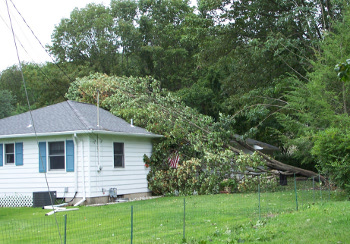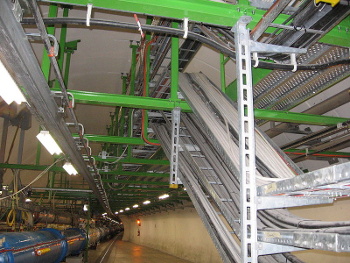Cosmic Cooling
August 30, 2011
We've just experienced
Hurricane Irene, so
weather is on our minds. Our home in
Northern New Jersey had no damage, but my neighbor wasn't as lucky, as the photograph below illustrates.

Fallen Tree associated with Hurricane Irene, August 28, 2011.
There were no injuries. The particular way that the tree landed, parallel to the roofline, minimized damage.
(Photo by author)
It's times like this that you think that the
universe may be out to get you. Well, it might just be, but not in the way you might think. A recent paper in
Nature reports on how
galactic cosmic rays affect atmospheric
aerosol nucleation; and, thereby,
climate.[1-6] The paper reports on the
CERN CLOUD experiment, in which a
particle accelerator was used to generate a faux cosmic ray stream to examine its affects on aerosol-producing reactions in
Earth's atmosphere.
This was a major international collaboration that involved scientists from CERN (Geneva, Switzerland), the
Goethe-University of Frankfurt (Frankfurt am Main, Germany), the
University of Lisbon and the
University of Beira Interior (Lisbon, Portugal), the
University of Leeds (Leeds, United Kingdom), the
University of Helsinki (Helsinki, Finland), the
Helsinki Institute of Physics (Helsinki, Finland), the
University of Vienna (Vienna, Austria),
Ionicon Analytik GmbH and the
University of Innsbruck (Innsbruck, Austria), the
Paul Scherrer Institut (Villigen, Switzerland), the
Leibniz Institute for Tropospheric Research (Leipzig, Germany), the
University of Milan (Milan, Italy), the
California Institute of Technology (Pasadena, California), the
Lebedev Physical Institute (Moscow, Russia), the
University of Eastern Finland, (Kuopio, Finland), the
NOAA Earth System Research Laboratory (Boulder, Colorado), the
Finnish Meteorological Institute (Helsinki, Finland) and
Aerodyne Research Inc. (Billerica, Massachusetts).[2]
The experiment was the first to use a particle accelerator in an atmospheric science experiment.[5] The
CERN Proton Synchrotron was used as a laboratory source of "cosmic rays" that were sent through a reaction chamber, which was a modified particle detection
cloud chamber.[5] This laboratory setting for an atmospheric experiment allowed control of all variables, such as
temperature,
pressure, cloud
chemical composition and cosmic ray intensity.[5]

Great set for a
James Bond movie
Part of the Large Hadron Collider conduit tunnel at CERN.
(Photo by Julian Herzog, via Wikimedia Commons))
Satellite observations have shown a possible correlation between cosmic-ray intensity and low cloud cover.[5] The idea is that the cosmic rays will seed the formation of aerosol particles in the atmosphere. Cloud cover is an important aspect of the Earth's
energy balance, and changes of cloud cover of just a few per cent will affect climate.[5] Human activities that have lead to increased aerosols in the atmosphere may have offset much of the affect of greenhouse gases on global warming.[6]
Aerosol particles in the atmosphere have a cooling effect, since they
reflect sunlight, and they form additional cloud drops, making clouds brighter. They also aid in the persistence of cloud cover.[1-2] Current estimates are that half of cloud droplets are formed when trace gases combine in the atmosphere. [3-4]
Current
climate models assume that
sulfuric acid and
ammonia in the atmosphere interact with water to form aerosols, but the CERN results show that this mechanism is responsible for just a small percentage of the aerosol particles. [4,6] Climate models will require revision, since all of these assume that the aerosol nucleation is through chemical interactions of particular species, alone.[4] Said, Jasper Kirby, lead scientist of the CLOUD experiment,
"It was a big surprise to find that aerosol formation in the lower atmosphere Isn't due to sulphuric acid, water and ammonia alone... Now it's vitally important to discover which additional vapors are involved, whether they are largely natural or of human origin, and how they influence clouds. This will be our next job."[6]
The CERN CLOUD experiment discovered that atmospheric ionization by cosmic rays increased the formation of aerosol particles by up to a factor of 10. This was particularly true for the
mid‐troposphere and above, where temperatures are cooler. In that region, aerosols can form just from sulphuric acid and water vapor without any additional gases being present.[4,6]
The CERN CLOUD apparatus is also capable of doing atmospheric chemistry experiments that don't involve cosmic rays. One result of these is that ammonia concentrations of just 100 parts per trillion by volume, or less, increase the nucleation rate of sulfuric acid particles 100–1,000-fold.[1-2]
References:
- Jasper Kirkby, et al., "Role of sulphuric acid, ammonia and galactic cosmic rays in atmospheric aerosol nucleation," Nature, vol. 476, no. 7361 (August 25, 2011), pp. 429-433.
- Complete author list for Ref. 1 is as follows: Jasper Kirkby, Joachim Curtius, João Almeida, Eimear Dunne, Jonathan Duplissy, Sebastian Ehrhart, Alessandro Franchin, Stéphanie Gagné, Luisa Ickes, Andreas Kürten, Agnieszka Kupc, Axel Metzger, Francesco Riccobono, Linda Rondo, Siegfried Schobesberger, Georgios Tsagkogeorgas, Daniela Wimmer, Antonio Amorim, Federico Bianchi, Martin Breitenlechner, André David, Josef Dommen, Andrew Downard, Mikael Ehn, Richard C. Flagan, Stefan Haider, Armin Hansel, Daniel Hauser, Werner Jud, Heikki Junninen, Fabian Kreissl, Alexander Kvashin, Ari Laaksonen, Katrianne Lehtipalo, Jorge Lima, Edward R. Lovejoy, Vladimir Makhmutov, Serge Mathot, Jyri Mikkilä, Pierre Minginette, Sandra Mogo, Tuomo Nieminen, Antti Onnela, Paulo Pereira, Tuukka Petäjä, Ralf Schnitzhofer, John H. Seinfeld, Mikko Sipilä, Yuri Stozhkov, Frank Stratmann, Antonio Tomé, oonas Vanhanen, Yrjo Viisanen, Aron Vrtala, Paul E. Wagner, Hansueli Walther, Ernest Weingartner, Heike Wex, Paul M. Winkler, Kenneth S. Carslaw, Douglas R. Worsnop, Urs Baltensperger, Markku Kulmala.
- CERN’s CLOUD experiment provides unprecedented insight into cloud formation, CERN Press Release No. PR15.11, August 25, 2011.
- Supporting information to press briefing on Nature publication, Kirkby et al., "Role of sulphuric acid, ammonia and galactic cosmic rays in atmospheric aerosol nucleation", CERN, July 29, 2011.
- CLOUD – Cosmics Leaving OUtdoor Droplets, Cosmic rays and cloud formation, CERN Web Site.
- Kathryn Grim, "Cloud-formation study at CERN to influence climate models," Symmetry Magazine (Fermilab/SLAC), August 25, 2011.
Permanent Link to this article
Linked Keywords: Hurricane Irene; weather; Morris County, New Jersey; Northern New Jersey; universe; Nature; galactic cosmic rays; aerosol; nucleation; climate; CERN; CLOUD experiment; particle accelerator; Earth's atmosphere; Goethe-University of Frankfurt (Frankfurt am Main, Germany); University of Lisbon; University of Beira Interior; (Lisbon, Portugal); University of Leeds (Leeds, United Kingdom); University of Helsinki (Helsinki, Finland; Helsinki Institute of Physics (Helsinki, Finland); University of Vienna (Vienna, Austria); Ionicon Analytik GmbH; University of Innsbruck; (Innsbruck, Austria); Paul Scherrer Institut (Villigen, Switzerland); Leibniz Institute for Tropospheric Research; (Leipzig, Germany); University of Milan (Milan, Italy); California Institute of Technology (Pasadena, California); Lebedev Physical Institute (Moscow, Russia); University of Eastern Finland, (Kuopio, Finland); Finnish Meteorological Institute (Helsinki, Finland); Aerodyne Research Inc. (Billerica, Massachusetts); CERN Proton Synchrotron; cloud chamber; temperature; pressure; chemical composition; James Bond movie; Large Hadron Collider; Julian Herzog; Wikimedia Commons; Satellite observations; first law of thermodynamics; energy balance; albedo; reflect sunlight; climate model; sulfuric acid; ammonia; mid‐troposphere.